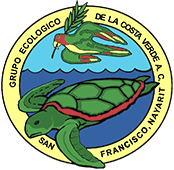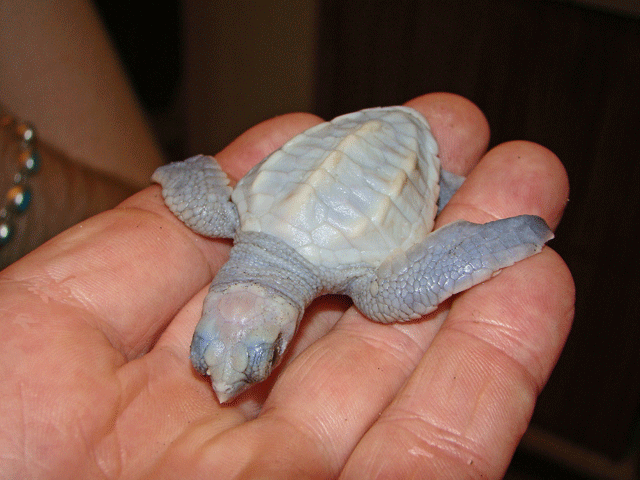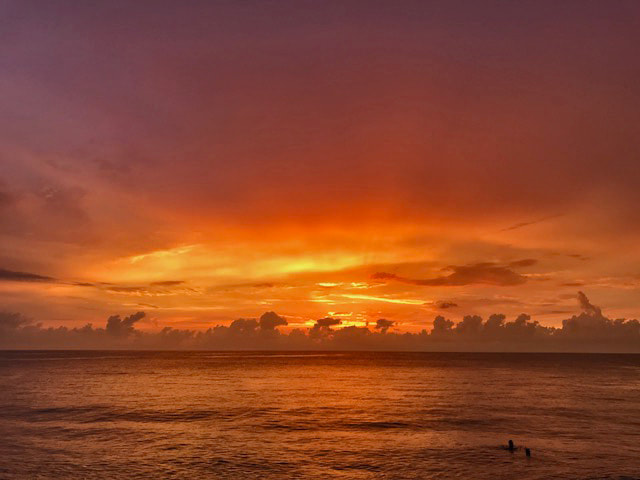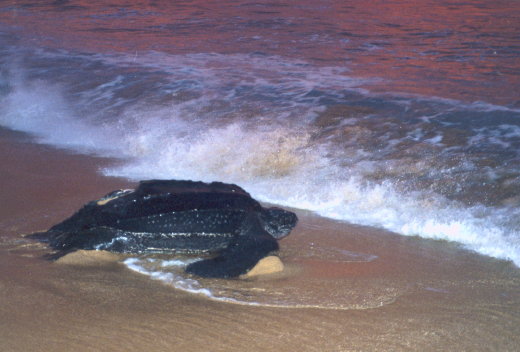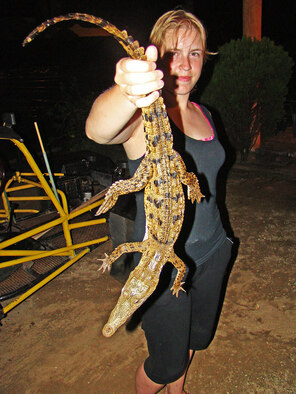Sea Turtles could soon be faced with extinction
In the spring of 1992 the founding members of the Grupo Ecológico de la Costa Verde, A.C. organized and built a marine turtle nursery in San Francisco, Nayarit, Mexico. By June of that year the protection of Olive Ridley and Leatherback turtle eggs had begun.
Millions of years before humans arrived in North America, the marine turtle had well established its nesting habitat along the coastal waters of Mexico. The oldest inhabitants of San Francisco, Nayarit, or "San Pancho" as it is commonly called today, can still recall the nights when hundreds of nesting turtles climbed the moonlit beaches to renew the custom of perpetuating their species. The palm-laden playas were free of development and offered an idyllic location for nesting. Occasionally, the coastal Aboriginals would gather food from the generous supply of eggs and turtles. The growing human population, coupled with the changing demographics of the coastal region in the past one hundred years, has dramatically built on and altered the beaches, and thus effected the reproduction cycle of the turtles. By 1988, pressures from coastal development, poaching, shrimp fishing, and tourism reduced a population of tens of thousands to less than 200 nesting turtles per year. |
Our first and only Leucistic Hatchling.
Sunset in San Pancho
|
The loss of beachfront hasn't been the only problem that turtles face. Like all reptiles, turtles are very sensitive to changes of climate. With the gradually warming temperatures, more and more turtles are hatching as female. At our current rate of climate change, it is projected that turtles may be completely female in 50 years.
Temperatures don't just effect the turtle offspring, but also the ocean. The warming water has caused an increase of toxic algae. Over-fishing, and carelessness of industrial fishing is another, serious killer of the sea turtle.
Temperatures don't just effect the turtle offspring, but also the ocean. The warming water has caused an increase of toxic algae. Over-fishing, and carelessness of industrial fishing is another, serious killer of the sea turtle.
"In 27 years the population has increased from 200 to 1,475 nests"
|
A Female Leatherback Sea Turtle Makes Her Way Back to the Ocean
|
The first conservation effort to protect the marine turtle began in the late eighties. It was then that members of the community became concerned that the local marine turtle population may soon face extinction.
In the spring of 1992, the founding members of the Group built the first marine nursery. By June, a large scale protection of Olive Ridley and Leatherback turtle eggs had begun. In 20 years the population of the Olive Ridley has increased from 200 to 1,475 nests. However, the rare and ancient Leatherback has become more endangered over the years. Our beaches are slightly too cold to have reliable, successful incubation and the females rarely come up. |
Purpose
On April 16th of 1993, Grupo Ecológico de la Costa Verde, A.C. received authority from the Mexican Government to begin the first environmental group in the State of Nayarit. Within the Fifth Clause of the Group's Constitution or Statement of Purpose" as follows:
Fifth Clause (as translated)
The object of the Association that today is formed is:
Expanding within the scope of the Fifth Clause:
Fifth Clause (as translated)
The object of the Association that today is formed is:
- Protection of the environment along the Green Coast, with special interest in protecting the Turtles.
- Develop and establish programs of environment education for the community and visitors.
- Gathering ecological information and share it with other ecological groups and government.
- Improving the development of the communities that inhabits in this coast. As well as the undertaking of all appropriated acts that are necessary for the entire execution of the purpose of this association
Expanding within the scope of the Fifth Clause:
- Protection of the environment with special interest in the preservation of the marine turtles as well as all other endangered species of flora and fauna along the Pacific Coast of Mexico.
- The preservation and improvement of wildlife habitats with special interest in coastal forest, wetlands, beaches, and rivers.
- Provide environmental education programs emphasizing environmental accountability and preservation.
- Protection of visual and natural resources of the coastal region by introducing alternative lifestyles, including but not limited to acceptable methods of fishing, farming, building, and landscaping, that will in the long term minimize negative impact on the environment.
- Assisting government agencies and other environmental groups by developing plans and programs designed to protect in perpetuity the terrestrial and marine environment for wildlife, ecological and aesthetic purposes beneficial to the public interest.
- Improving the development of communities by providing as necessary trash containers, community clean up campaign, care and maintenance of parks, and other programs and plans as required to insure public health and welfare.
Our History
On April 16, 1993, Grupo Ecológico de la Costa Verde, A.C. received official recognition by the Mexican Government to become the first environmental non-profit civil association of the region with the special interest in the protection of the marine turtle. Through the Mexican Government, SEMARNAT (Secretary of the Environment and Natural Resources) the Group was granted permission to continue its work along the neighboring beaches.
The Board of Directors consists of a combination of members including a President, Secretary, Treasurer, and other Secretaries to carry out the objectives and goals of the Group. The Members, Officers, and Board of Directors make up the General Assembly who collectively vote on all business matters.
The Officers of the Board of Directors serve on the Board for two years or are re-elected. The current Officers of the Group are:
Financial support to achieve our objectives comes from the sale of T-shirts and public donations, and from on other sources. All donations and sales go directly toward the Group's environmental objectives in the most cost effective manner possible, including, but not limited to our marine turtle program, children's environmental education, community-beach cleanup, and the preservation of the jungle.
The Board of Directors consists of a combination of members including a President, Secretary, Treasurer, and other Secretaries to carry out the objectives and goals of the Group. The Members, Officers, and Board of Directors make up the General Assembly who collectively vote on all business matters.
The Officers of the Board of Directors serve on the Board for two years or are re-elected. The current Officers of the Group are:
- Jessica Schmidt, Director
- Frank D. Smith, Technical Advisor
- Maria Elvia García Palomera, Secretary
- Karen Sorum, Treasurer
Financial support to achieve our objectives comes from the sale of T-shirts and public donations, and from on other sources. All donations and sales go directly toward the Group's environmental objectives in the most cost effective manner possible, including, but not limited to our marine turtle program, children's environmental education, community-beach cleanup, and the preservation of the jungle.
Ways to Donate: PayPal or Adopt a Sea Turtle Nest
Come Visit our Turtle Nursery!
Call or email in advance so we can prepare for your visit.
Please note that we work at night so morning calls may be missed.
|
|
